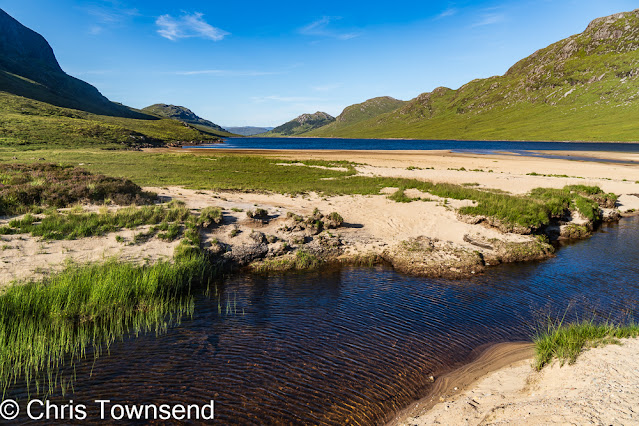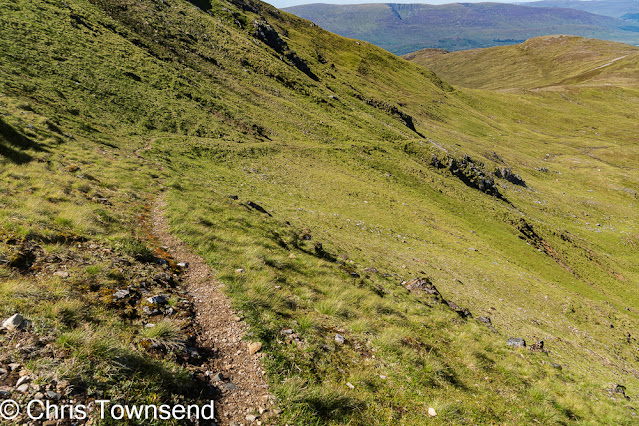 |
| Lochan na h-Earba |
Hillwalking in a heatwave is hard work, especially carrying camping gear. The forecast was for a few days of clear skies and light winds when I planned the trip. After became a forecast for a heatwave I decided to go anyway and modify my plans if necessary.
I’d been planning to visit the Ardverikie area south of Loch
Laggan since March when the Scottish Government granted permission (see here)
for a huge pumped storage scheme that will drastically change this wild area. I
wanted to see it again before it became a different and diminished place.
 |
| Foxgloves & the Abhainn Ghuibinn |
I set off late, hoping to avoid the hottest part of the day. I don’t know if I did but it was certainly very hot, the air still and heavy. The land looked lush and green. Lines of red and white foxgloves edged the track. As long as I kept my place slow it was lovely walking.
Soon I reached Lochan na h-Earba under the walls of craggy
Binnein Shuas, only 747 metres high but a rugged hill with a classic rock climb,
Ardverikie Wall, on its cliffs. At the southern end of the lochan is a golden
sandy beach, a lovely spot. A few tents dotted the grass at the sand’s edge. It
is a grand place for wild camping.
 |
| Lochan na h-Earba |
Lochan na h-Earba is a double lochan as the same name applies to the next lochan in this narrow glen between steep hills with just a half kilometre of flat land, Am Magh, between them. When the hydro comes this will disappear under the waters of a reservoir as the twin lochans become one with dams at both ends. That will be a sad day.
I considered joining the campers by the beach but there were
still several hours of daylight left so I pushed on up a steepening stony path into
Coire Pitridh and then to the Bealach Leamhain at almost 750 metres. Here I
pitched my tent on rough ground that was probably boggy in wet weather. This
night it was dry enough.
 |
| Loch a' Bhealaich Leamhain evening |
Just beyond my camp I could look down on Loch a’ Bhealaich Leamhain, a jewel set between the steep rugged walls of two Munros, Beinn a’ Clachair and Geal Charn. This will be the upper loch of the hydro scheme, with a large dam at one end. Low sunlight lit the grasses on the bealach. The waters of the loch shimmered in the breeze. The sky and the hillsides glowed. A wild peaceful place. For now.
 |
| Bealach camp |
I settled into my tent. The light wind kept off the midges for a while but died away as it grew dark. A few bites and I had the doors zipped shut, even though it was quite stuffy inside. The air did cool in the darkness though, dropping to 12°C, and I was able to sleep for several hours, until the rising sun woke me with brightness and a rapidly rising temperature.
 |
| Loch a; Bhealaich Leamhain morning |
I wandered over to look at the loch again. The water was a deeper blue, undisturbed except for one little whisper of wind. The grasses glowing in the sunshine again but the slopes either side were shadowed. It felt an enchanted place.
By the time I set off the heat was building rapidly. A rough
path took me up to the col between Creag Pitridh and Geal Charn. I had intended
on climbing the former, another Munro, as it’s less than 100 metres above the
col and just half a kilometre away before heading up Geal Charn but I was
already feeling the effects of the heat and not quite enough sleep. A rest
seemed much more attractive, especially as I found a shaded spot behind a boulder.
It’s not often conditions are right for a nap outside during a summer’s day
high in the Scottish hills, midges or the weather usually moving me on quickly.
I was glad to take advantage of the opportunity.
 |
| Creag Pitridh |
The rest lasted two hours, at least half of which I spent asleep. I felt rested and relaxed. So relaxed I could have stayed there all day. I wanted to climb Geal Charn though, or rather I wanted to descend Geal Charn. On the map I’d noticed a path marked on the north side of the hill that eventually curved down to Am Magh. I’d found no mention of it in any guidebook. Did it still exist? I wanted to find out. The situation looked excellent as it traversed across steep slopes high on side of remote Coire an Iubhair Mor.
 |
| Geal Charn |
A steep stony path led up to the extensive plateau-like Geal Charn, a path not marked on the map, though it is well-used and described in every guidebook. As the path levels out the distinctive summit cone appears, its sides strewn with the pale stones that give the hill its name – Geal Charn meaning white hill. On some maps it also has the alternative name Mullach Coire an Iubhair, the top of the corrie of the yew tree. I could see no trees in the corrie below nor did it seem likely that yew trees ever grew this high. There’s a big well-built cairn and a circular trig point on the top. I rested here a while, enjoying the extensive view. In the sun my thermometer read 42°C. There was a breeze though, which took the edge off the heat.
 |
| Summit cairn and trig point |
A short descent led to the steep edge of Coire an Iubhair Mor. I could see the path not far below and follow its snaking line across the corrie wall. It looked even better than on the map, and better still when walked. It’s well-constructed and wider than a walker’s path, made, I think, for ponies. In places it’s fading away, in other crumbling and narrow, but still easy to follow. The only tracks I saw were those of deer. Not far below a little lochan lay in the heart of the corrie.
 |
| Marvellous & neglected |
I thought this path lovely and easily the best way up Geal Charn, which is an underrated hill. But I could see why the path was neglected. It’s on the wrong side of the hill for combining Geal Charn with Creag Pitridh and Beinn a ‘Clachair, the round of these three Munros being a standard route and recommended in every guidebook.
 |
| Looking back up the path to the rim of Coire an Iubhair Mor |
Leaving the corrie rim the path ran down to the Allt a’ Mhaigh (Moy Burn). As I descended the breeze dropped away and the air became stifling. The clegs (horseflies) came out and I wasted precious energy slapping them away. Despite this and adding insect repellent to the sunscreen and sweat I was still bitten painfully a few times, smears of blood decorating my arms and legs.
 |
| Loch na h-Earba & Binnein Shios |
Lower down the path faded away into boggy ground. I could see the north-easterly Lochan na h-Earba and craggy Binnein Shios, a companion to Binnein Shuas. Soon I was down on Am Magh and the estate track that runs along this long glen.
 |
| Am Magh & Lochan na h-Earba |
Am Magh is another lovely peaceful place. There are a few trees here and many more on the flanks of the hills either side of the north-easterly lochan. If I’d been out for a second night I’d have camped here. As it was I tramped the track alongside the other lochan back to the golden beach and on to my car and the main road. The heat didn’t relent and I stopped regularly for water and a rest. I probably drank five times as much as usual on a day out. On the way home I heard that the temperature reached a record 32.2°C in Aviemore, which wasn’t far away.
 |
| Binnein Shuas & Loch na h-Earba |
I’m glad I visited this area again. It’s how I shall remember it. If the hydro is constructed I doubt I’ll return.
There was a campaign against the hydro scheme. Parkswatch
Scotland ran several excellent piece such as Free
market landscape destruction by Nick Kempe and Shafting
Ardverikie – the fate awaiting its lochs, corries, bens and fine old hill paths
by David Jarmin. The last, which I only read after my walk, describes the Coire
an Iubhair path. The John Muir Trust made
a formal
objection too but all the campaigning was to no avail. A beautiful area of
wild land is to be lost.

No comments:
Post a Comment